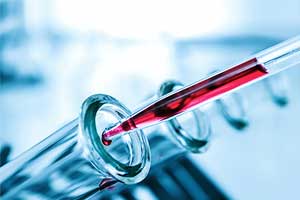- Home
- Editorial
- News
- Practice Guidelines
- Anesthesiology Guidelines
- Cancer Guidelines
- Cardiac Sciences Guidelines
- Critical Care Guidelines
- Dentistry Guidelines
- Dermatology Guidelines
- Diabetes and Endo Guidelines
- Diagnostics Guidelines
- ENT Guidelines
- Featured Practice Guidelines
- Gastroenterology Guidelines
- Geriatrics Guidelines
- Medicine Guidelines
- Nephrology Guidelines
- Neurosciences Guidelines
- Obs and Gynae Guidelines
- Ophthalmology Guidelines
- Orthopaedics Guidelines
- Paediatrics Guidelines
- Psychiatry Guidelines
- Pulmonology Guidelines
- Radiology Guidelines
- Surgery Guidelines
- Urology Guidelines
Scientists develop new simple blood test of tuberculosis

Scientists develop a new simple blood test of tuberculosis.
Sputum Testing for Acid fast bacillus or TB bacteria is the gold standard test for diagnosis of tuberculosis.But it is not easy for everyone to undergo it because at times kids and people with HIV/AIDS, can not cough up sputum from their lungs.
A team led by Niaz Banaei, an associate professor of pathology and of medicine, and Juan Santiago, a professor of mechanical engineering have built a prototype device that searches for signs of tuberculosis in blood and urine samples.
This device requires very little electricity to run and could eventually be used in the developing world where most new tuberculosis cases occur and will also circumvent problem of bringing out phlegm.
The device is a simple method to get a pure a sample of DNA by separating the relevant DNA bits from everything else in blood and urine. The device could work well in a doctor's office with limited electricity and equipments.
With over 3 million tuberculosis cases going undiagnosed each year, the device could have "big advantages at the individual level and big advantages at the public health level," said Catherine Hogan, a global health diagnostics fellow and visiting instructor in the Department of Pathology, who is collaborating on the project with Banaei, Santiago and Futai Nobuyuki, a visiting scholar in mechanical engineering.
First steps toward a new test
Tuberculosis usually attacks patients' lungs, so to test for the tuberculosis bacteria doctors need to get patients to cough up fluid – the technical term is sputum – from their lungs. Unfortunately, not everyone can cough up sputum. Kids and people with HIV/AIDS, for example, struggle to do so.
One way to get around this problem would be to search blood and urine for tuberculosis bacteria DNA. The problem is that there is usually little DNA amidst a sea of proteins and other molecules.
For that, Banaei turned to Santiago, whose lab has been working on removing impurities from DNA and blood for more than a decade.
The team devised a system that takes advantage of the fact that DNA and other molecules found in blood plasma and urine have different electric charges. Placed in an electric field, the molecules move at different speeds.
As a result, the team can place blood or urine in an electric field so low-power they can run the device off a USB port, wait for different molecules to sort out, then scoop up the DNA and run standard tests to see if any came from TB bacteria. Although the team still has to do some preparation on the samples, preliminary tests in eight patients suggest the new test is simpler and more reliable than previous approaches.
Next steps
Next, the team has a Stanford ChEM-H seed grant to optimize their approach and test it in a variety of more challenging situations; for instance, they need to find out how well it works in children of different ages or how well it performs for HIV/AIDS patients at different stages of infection. They also need to know how factors such as sample freshness or even whether a patient is already being treated for TB affect the test's accuracy.
Longer term, Banaei, Santiago and colleagues hope their test can contribute to a broader World Health Organization goal of eliminating tuberculosis
Provided by Stanford University
Explore further: Scientists develop a quick, cheap and portable test for diagnosing
BloodBlood testdevelopdiagnoseDiagnosisDNAeasyelectricitylessMovenewNew DeviceOffice testPUREPure DNAScientistssimplesputumTBtesttestsTuberculosisurine
Next Story
NO DATA FOUND

Disclaimer: This site is primarily intended for healthcare professionals. Any content/information on this website does not replace the advice of medical and/or health professionals and should not be construed as medical/diagnostic advice/endorsement or prescription. Use of this site is subject to our terms of use, privacy policy, advertisement policy. © 2020 Minerva Medical Treatment Pvt Ltd